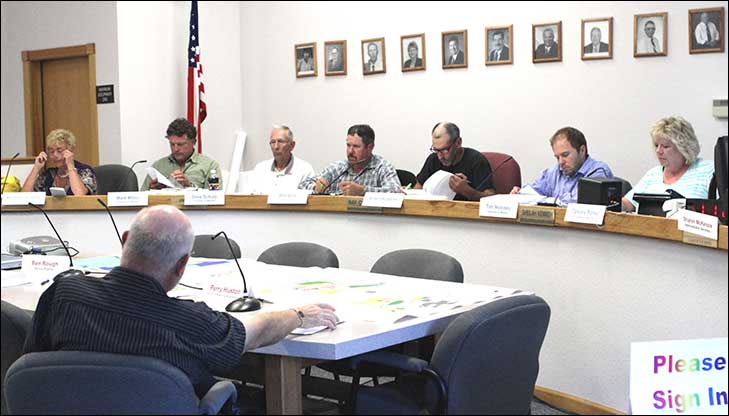|
A win for Methow water at planning commission
Watershed council projects Methow water shortage
by Solveig Torvik
Methow Valley citizens critical of Okanogan County's six-year-old effort to write a comprehensive land use plan won a victory Monday when the county planning commissioners unanimously voted to coordinate planning with water availability information provided by the Methow Watershed Council.
The council's 2011 water availability study found that under current zoning, the full build-out of all possible parcels would leave 24,313 of 26,133 possible parcels in the Lower Methow reach from Twisp to Pateros and 127 parcels in the Upper Methow reach west/northwest of Winthrop unable to get water from a permit-exempt domestic well.
Even with a build-out that assumes no new, subdivided parcels, the Lower Methow reach from Twisp to Pateros will exceed its water reserve under current zoning. That means 1,092 presently existing parcels out of a total 2,913 existing parcels will be unable to get water from exempt wells, the study found.
If all sub-dividable parcels are developed as residential units under current zoning, there will be 32,000 residential parcels in the watershed, according to the study, with about 80 percent of them in the Lower Methow reach, where relatively small sized parcels are allowed.
The watershed council unsuccessfully has been urging the county commissioners to coordinate its land use planning with the council's findings on water availability, arguing that it would be "counterproductive" to propose a comp plan that results in an over-allocation of permit-exempt wells for single-home residences.
 Okanogan County Planning Commissioners (from left) Marlene Rawley, Mark Miller, Dave Schulz, Phil Dart, Albert Roberts, Tim Woolsey and Tamara Porter listen to county planner Perry Huston (back to camera) explain proposed comprehensive land use plan. -Photo by Solveig Torvik Okanogan County Planning Commissioners (from left) Marlene Rawley, Mark Miller, Dave Schulz, Phil Dart, Albert Roberts, Tim Woolsey and Tamara Porter listen to county planner Perry Huston (back to camera) explain proposed comprehensive land use plan. -Photo by Solveig Torvik
The planning commissioners on Monday were "more respectful than normal" of water concerns of Methow Valley residents, Isabelle Spohn of the Methow Valley Citizens Council told Grist after the July 22 meeting. "But true value of the statement they added on water is unclear to me," she added.
"It's clear the planning commission has taken an interest in the water issue," said Jason Paulsen, executive director of the Methow Conservancy in Winthrop. But, he cautioned, final decisions rest with the county commissioners.
The action on the Methow water issue came at the request of former county commissioner and current planning commissioner Dave Schulz of Twisp. He warned that if the county does not incorporate existing water resource information in its land use planning, it faces the possibility that the state will once again impose a building moratorium.
"You'll have to address this or we'll have another moratorium" Schulz told county planner Perry Huston. "I don't want to see a moratorium in Okanogan County.The Department of Ecology will do that," warned Schulz, who became county commissioner in 1992 at the time when Ecology had imposed a building moratorium due to feared water shortages.
Water information on the Methow Basin watershed was compiled in recent decades following the 1976 issuance by the state Department of Ecology's of its so-called WRIA 48 In-stream Flow Rule, said Schulz. That rule limits the availability of water appropriations to 2 cubic feet per second for exempt single-home domestic wells in each of the seven reaches in the Methow Basin.
The language inserted into the comp plan Monday at Schulz's request states: "It is the intent in the completion of this comprehensive plan to ensure coordination with ongoing water resource planning conducted for WIRA 48 and 49." (49 pertains to water appropriations for the rest of the county).
The existing water availability information "took years to complete" and is available for use in the comprehensive planning process, said Schulz, who lamented: "We just can't learn from history."
The current comp plan draft addresses population growth, density and resource lands and rural lands designations. It does not address water availability, and critics contend this means the county is embarked on a deeply flawed approach to land use planning.
Huston told the commissioners that after the comprehensive plan is adopted, the next step will be to prepare a zoning plan. "That's where your watershed plan will inform those decisions," he said.
But Spohn and Maggie Coon of the Methow Valley Citizens Council object to that approach. "Having water planning and land use planning on two separate tracks does not make sense," they contend.
County commissioners have been criticized for their decision to separate the zoning process from the comprehensive planning process. Critics also object to the removal of specifics in the current planning document, arguing that it is too vague.
Huston told the commissioners that the reason the plan before them now is different than the one they saw four years ago is that the county commissioners, attempting to respond to community feedback, sought to remove "anything that smacked of regulation" or perceived as being too prescriptive. He said the zoning process will provide "a higher level of specifics."
But Spohn said that since there will be no Environmental Impact Statement prepared for the zoning ordinance, for example, there will be no real guidance for commissioners about the impact of various alternatives.
The commissioners deferred further action on the plan until their Aug. 26 meeting.
7/24/2013
see past stories in the archive >>
|
